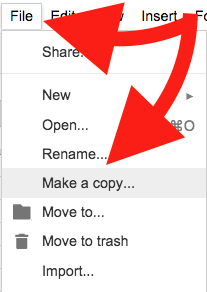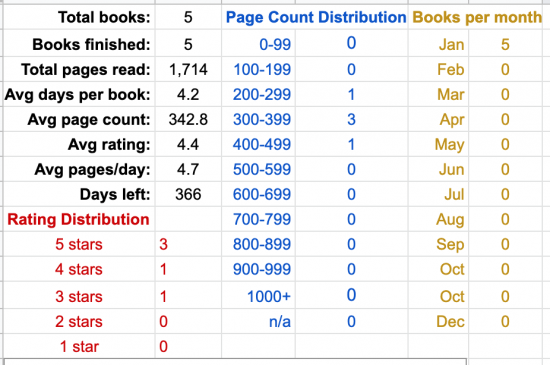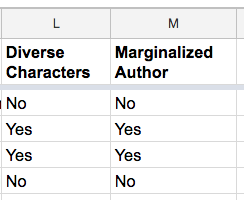 It’s sharing time! Over the past few years, we’ve shared different versions of this reading tracking spreadsheet and each year it’s been improved by one of you! And I’ve received so many email messages and requests for more options from readers who absolutely adore it.
It’s sharing time! Over the past few years, we’ve shared different versions of this reading tracking spreadsheet and each year it’s been improved by one of you! And I’ve received so many email messages and requests for more options from readers who absolutely adore it.
Like 2021, this past year has been a difficult one for reading for many people. Sometimes reading was all I wanted to do, and sometimes I struggled to get into a book. I still used my tracking spreadsheet, though, and adding new titles gave me a little boost every time.
The value of keeping up with my reading tracking each year is that it helps me maintain two habits that I value:
- Logging my reading each week (or every few days)
- Examining what I am reading more closely as the data set builds
The great thing about this spreadsheet is that it’s so very easy to customize – especially now. You can modify or add columns of data and track the things that are important to you. I’ve made additions to track where I found the book (e.g. Library, NetGalley, Amazon, Kobo, Hoopla, etc).
Most Important!
First, and most important, THANK YOU ANDREA. The original spreadsheet was created and shared by Andrea in the comments of podcast Episode 275 about Reading Habits. Thank you so, so very much, Andrea. We wish you the most excellent of reading for the rest of your waking life.
And second, THANK YOU ESTELLE AND MAX! The spreadsheet is SUPREMELY easy to customize thanks to Estelle and Max’s alterations, and I cannot tell you how much I love it.
Thank you to Elizabeth, Janet, and many others who have commented about their own improvements and suggestions, some of which I’ve incorporated to improve this one.
Want to get started and not read any more about tracking your reading? I get it – here, you can go directly to the spreadsheet download link.
If you’re curious about why and how we track our reading using this shared spreadsheet, read on!
Tracking your reading?
Doesn’t that mean you’re entering a lot of books?
Oh, yes. Yes, it does. And that means delicious, nutritious data!!
Some background: I’ve been using – wow, for four years now – a very simple Google spreadsheet to track my future reading. I needed to know four major pieces of info:
- what I wanted to read and when
- what genre it was
- when the book was coming out
- where the book or ebook file was so I could find it.
Present and Future Sarah do not ever remember what Past Sarah did, so Past Sarah tries to help out by leaving us notes. And since I receive a lot of books well in advance of publication date, or after a long library hold, leaving myself a record helps me manage my reading.
In the version I share here, I’ve combined my Planning sheet and Andrea’s original Reading sheet into one spreadsheet with three tabs. You don’t have to use the To Be Read tab if you don’t want to, but in case it would be useful, it’s available.
Back in 2019 (remember then?) I set reading goals for myself (and met them – yay, me!) and I learned to set a weekly reminder on my ToDo-ist to log my reading every Friday so I don’t miss anything. (NB: affiliate link if you want to try ToDo-ist out – I use it to run most of my daily life, alongside Google Calendar.)
Because I’ve been tracking my reading list and my reading habits for so long, I have insights into my reading tastes, what books I sped through quickly, which ones I savored, and which genres are showing up in greater numbers in my history. Each year I make a few changes based on those insights to capture new things I want to track.
You do not, of course, have to use the columns in the sheet as given. You can track whatever you want, and change them to account for aspects of your reading that are important to you. This is why the spreadsheet is so nifty, and why I really enjoy using it.
Here’s a link to a copy of the 2022 Reading Tracking Spreadsheet:
https://docs.google.com/spreadsheets/d/1EXB9SHyh4HeVNTugfV1JefLjDjmZ0jQQz39NnJhsMug/edit?usp=sharing
This link is view-only.
Ahem.
This Link is View-Only.
All you need to do is click File, then Make a Copy to save your own version to your Google Drive.

Let’s take a tour, shall we?
Starting with the Books Read 2022 tab: this is where you enter the data on the books you’ve read.
![]()
Title, Author, Series, Pub Date, Pages, Format, and the date started, ended, and days read fields are all pretty self explanatory.
The genre fields, and the fields about diverse characters and marginalized writers require a few notes.
First, be consistent about what terms you use. Currently, the genres listed are as follows:
- DNF
- Category Romance
- Contemporary Romance
- Erotic Romance
- Romantic Suspense
- Women’s Fiction
- Historical Romance
- Paranormal Romance
- Fantasy Romance
- Sci-Fi Romance
- Graphic Novel
- Fantasy
- Urban Fantasy
- Steampunk
- Sci-Fi
- Historical Fiction
- Mystery
- Thriller
- Nonfiction
- Teen/YA
- Other/TK
You can use different terms but it requires some editing of the labels on the next tab – more on that in a moment. You can also use more than one term to describe a book.
Under columns such as Diverse Characters and Marginalized Writers, you also need to be consistent in what you enter in those fields. You can use “Yes” and “No” as the answers, as I have in the sample data, or you can be more specific, as the chart on the next tab will support multiple terms. Just be consistent. You can’t mix up “Yes” and “yes” or your data will be a bit wonky.
In Book Source, I am tracking where my books come from: the library? Amazon KU? Kobo? Hoopla? NetGalley? As with the other columns, you have to be consistent (e.g. “NetGalley” and “Netgalley” will produce separate results in the charts on the next tab) but you can enter as many sources as you use to find your books: Scribd, AO3, FanFiction.net, Tumblr, Libby, Little Free Library, etc. The possibilities are endless.
You don’t have to use any of these columns if you don’t want to, of course. You can make up your own things to track. Just make sure to use consistent terms for that data so the Statistics render correctly.
Statistics
Now let’s look at the Statistics page because this is where the magic happens.
Andrea, as the original creator of all this spreadsheet magic, deserves all the praise and applause, as do Estelle and Max for upgrading the genre list to make it even easier to edit!

I love this gif and I love the cream gown on the woman who stands up first. Anyway.
On the second tab, the data you entered from the first tab is turned into graphs, statistics, and charts that allow you to see the results of your reading.
Pivot Tables, Oh Yeah.
The spreadsheet as I’ve shared it has some sample data that you can delete, obviously. That data is only provided to give you a preview of the statistics that are being tracked.
For example:

Books Per Month, Rating Distribution, and Page Count are also displayed in graph form below those tables.
Then we get to Categories and this is the part that Estelle and Max improved so brilliantly.
Here’s the current list of Categories:

Thanks to the magic of Estelle and Max’s edits, all you need to do is change the label of the category in Column G.
Change the name, and make sure you use that name in the same format on the Books Read 2022 tab.
The category statistics are compiled from the data entered in column K of the “Books” tab. So if you added “Historical Fiction, DNF” as the genre/category for Pride and Prejudice, your statistics would include 1 Historical Fiction and 1 DNF. As Andrea noted in her original construction, totals may be higher than total number of books because categories may overlap.
You’ll notice that several of the categories read “Other/TK.” It’s easy to make changes now: type in the genre or category you want to add, or change one of the existing labels to fit your tastes.
Again: the words you use have to be consistent, and that includes capital letters. “Western” and “western” are not interchangeable.
Additional Graphs – Make Your Own, Customize, Have Fun!
Then there are the graphs at the bottom: Diverse Characters and Marginalized Writers. You can adjust the titles and the data to fit your own needs or goals, of course.
The data you enter into columns L and M on the “Books” tab create the pie charts on the “Statistics” page:
So:

Becomes:

These charts are based on the sample data I entered, and I kept the fields as “Yes/No” for ease of demonstration.
You can customize these columns and charts to fit your own reading goals, interests, and habits.
For example, if you read mostly queer romance and want to focus on detailed representation of sexuality, instead of Column L reading “Diverse Characters,” you can change it to “LGBTQIA+?” and track more specific options, such as characters who identify as Gay, Lesbian, Transgender, Aro, Ace, etc.
So with this data:

The pie chart would look like this:

As long as you are consistent with the terminology, your chart should accommodate the data.
Make it your own to help you!
Again, the data shown here is all based on the sample books I entered. Once you delete the sample data and begin entering your own, you’ll see your own reading history. I have found using this spreadsheet to be very inspiring: I want to keep reading and keep adding to my totals, and I already read quite a lot.
Again, you can grab your own copy of the 2022 Reading and Books Data Spreadsheet by clicking this link, and, inside the Google Sheets menu, clicking “File — Make A Copy” to create your own spreadsheet inside your Google Drive.
I hope this spreadsheet is helpful. Again, massive thanks to Andrea for sharing the original version, and to Estelle and Max for the category upgrade, and to everyone who has made suggestions for refining and customizing each version.
What do you want to track? Do you think this will be useful for your own reading habits? And did you track last year? What did you think?
Happy New Year of Reading!


Although my desire to keep track of my reading may never progress beyond aspiration, I have a question: do fields in the Statistics tab automatically populate from the data in Books Read?
I think I need a database program which, in addition to the information on this spreadsheet, is able to sort titles, their position within a series and which I’ve read to date.
Thank you! I love these spreadsheets! Question – what do you do with the old spreadsheets, or more precisely, the lists of books from years past? Can you add a tab and combine them into a single ongoing list so you can search for all the books? It’s hard for me to distinguish one year from another so I am opening a lot of spreadsheets to find when I read the Kiss Quotient or Deal with the Devil.
Thank you, I love this. I struggled to read last year, and am determined to do more. I love the marginalized char & author columns as I want to ensure I am reading significantly more diverse authors and about richer characters besides the mainstream.
Thanks for this! The first thing I do is change the date formatting to be yyyy-mm-dd. Once I figured out how to do that last year I was a happy camper!
I love this spreadsheet, and I have personalized it to better match my needs — I keep one tab for current reading data, and another tab for past years reading data. I duplicated the “statistics” tab, so I can compare my reading habits this year with my past years history.
I have added “Series Order” to the data, so I know if I am reading #3 in a series, and I can search for #4.
I have added some columns I use with Omnibus books (for example, a single eBook containing all four Chesapeake novels by Nora Roberts). This helps me figure out if I am 23% through a novel, and not 37% through the massive eBook.
I am also playing with a Google Form to allow me to enter the data more easily. Once I get it healthy, I will be glad to share it with SB Sarah.
HOORAY for the spreadsheet! I cannot believe it’s been a year. I mean, it’s been 10 years or 2 months, who even knows what time is anyway. This spreadsheet showed me that I read a LOT more nonfiction than I thought, and I somehow read FOUR fantasy books this year even though that is usually NOT by genre. I have so many layers, like an onion, who knew?
I’m going to try doing this this year. We’ll see how it goes. I’ve never tracked my reading, and I rarely use my laptop these days so I’m not sure if I’ll remember to do it.
I have a couple of questions I’m hoping experienced users can help with.
1 – What’s the best way to track re-reads? Should I add it as a Category?
2 – I’d like to add a column after Rating where I can include comments. That’d probably be more helpful to me than just a letter grade. If I add a column after J, is the shifting of the following columns going to break anything in the Statistics tab?
I’m a little nervous about making changes in case I mess the whole thing up!
I just exported by Goodreads books. If it isn’t tracked on GR, I don’t track it, for instance no column for sexuality, and I don’t usually give the start date. Things I don’t want to know such as how many books got a 5* rating last year, or who is the author with the highest average rating from me, from which author have I read the most books in 2021,I can figure those out with pivot tables. Data is great!
@MaryK: I think you can track re-reads easily by adding it as a category, yes. Good idea!
I also have a column for notes/comments, which I added as the last column on the far right of the first sheet (that way I had room to add notes that wouldn’t push the other data I was collecting farther and farther off screen). Do you think that would work for you?
If it helps, I change one of the existing columns to ‘Status’ and fill it with New or Re-read.
And then, because I really want to know about it, I make a table in statistics, similar to the category one which counts it up. It is a simple three line, three column table: Columns: Total and Percent, and Rows New and Re-read. The formula for the fill in is [=COUNTIF(‘Books Read 2022’!M:M,”*New*”)] where M is the column with status.
And, because I like graphs, I make a pie chart showing the new vs re-reads. It is fun to watch it change over the year.
This spreadsheet is amazing. My friends and I have been tracking our reading using a shared Google Sheet since 2020 and this takes it to the next level!
I made a copy and added a Reader column up front so we can see who has read what.
The Statistics page is great for group statistics, but in our previous iterations we tracked individual statistics. Is there a spreadsheet wizard out there that can make a tab that can get individual stats based on a drop down populated by the Reader column?
I know what I want but have no idea how to make it a reality. I’ve only just discovered your blog and I think you’re my kind of people 🙂
I have an Excel spreadsheet I got years ago from Rosario, of the now-extinct Rosario’s Reading Journal blog. It is similar to your Google doc in that there’s a data tab and then tabs for statistics and graphs (I copy and create a new spreadsheet every year). Like Sarah, I have a comments column where I basically just copy the back cover description as a way to remember what the book is about but then add a few comments of my own – this is the most helpful column for me. If anyone wants a copy, I’m happy to share. Just note, it probably could use a bit of clean-up and updating at this point, but I do find it useful.
Thanks all!
SB Sarah, that’s a good point about the notes column needing more room to expand. It’s probably best for it to be the last column.